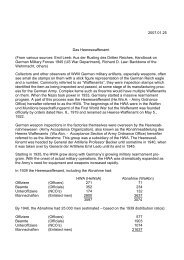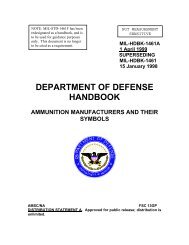Explosives-Nature, Use, Effects and Application.pdf
Explosives-Nature, Use, Effects and Application.pdf
Explosives-Nature, Use, Effects and Application.pdf
Create successful ePaper yourself
Turn your PDF publications into a flip-book with our unique Google optimized e-Paper software.
The function of the protective sheath is to prevent or minimize damage to the explosive core<br />
from abrasion or moisture. Various colorings <strong>and</strong> textile patterns are used to identify different<br />
strengths <strong>and</strong> types of detonating cord.<br />
While detonating cord has a general resemblance to safety fuse in that it has the same diameter<br />
<strong>and</strong> is supplied in rolls or coils, detonating cord is always distinguishable by its white powder<br />
core of PETN (pentaerythritol tetranitrate), an extremely powerful explosive. Pure PETN is<br />
white in color, but the addition of desensitizers may change its color slightly from pure white to<br />
light gray. PETN has no identifiable odor.<br />
Detonating cord is frequently known by a br<strong>and</strong> name such as Primacord, Primex, Detacord,<br />
Detonating Fuse, or Cordeau Detonant. Most of the common detonating cords are of the high<br />
energy military type, which contains about 60 gr of PETN per foot. Detonating cords up to<br />
400 gr per foot are manufactured for special purposes. There are other lower energy detonating<br />
cords designed for specific applications, especially for operations in developed areas where a<br />
diminished noise level is desired. For example, one low-energy cord, Detacord, has been<br />
developed with a core of only 18 gr of PETN per foot. Other low-energy cords include Mild<br />
Detonating Fuse <strong>and</strong> E-Cord, both with reduced core loading per foot.<br />
Detonating cord is used to detonate charges of high explosives in the same manner as blasting<br />
caps <strong>and</strong> for the same purpose. The detonating cord with its primary high-explosive core may be<br />
tied around, threaded through, or knotted inside explosives to cause them to detonate.<br />
Detonating cord is most commonly used when a simultaneous detonation of a number of<br />
explosive charges is planned <strong>and</strong> when it is not practical to use electrical circuits for this<br />
purpose. For example, to simultaneously detonate 10 dynamite charges placed 60.96 m (200 ft)<br />
apart in a straight line would require a minimum of about 548.64 m (1,800 ft) of electric firing<br />
wire <strong>and</strong> a considerable amount of time to prepare <strong>and</strong> test the electrical circuit. In contrast, a<br />
single line of detonating cord can be laid out from the firing point in a path that will pass near all<br />
of the dynamite charges. This long line is known as a trunk line. Shorter lengths of detonating<br />
cord, called down lines or branch lines, are attached to the charges <strong>and</strong> tied into the trunk lines.<br />
When a blasting cap is attached to one end of the trunk line <strong>and</strong> detonated, the detonating wave<br />
produced is transmitted through the trunk line <strong>and</strong> all the down lines to detonate the dynamite<br />
charges simultaneously. The detonating wave travels at approximately 6,400 m (21,000 ft) or<br />
nearly 6.44 km (4 miles) per second.<br />
Secondary High-Explosive Boosters<br />
Secondary high-explosive boosters are explosives that provide the detonation link in the<br />
explosive train between the very sensitive primary high explosives (blasting caps) <strong>and</strong> the<br />
comparatively insensitive main charge high explosives, which are also called primer explosives<br />
or simply primers. The explosives packaged for use as boosters are relatively sensitive <strong>and</strong> must<br />
be h<strong>and</strong>led carefully. Most, for example, will detonate on sharp impact such as that resulting<br />
from a small arms bullet. Due to this sensitivity, boosters are normally used in small amounts<br />
ranging from several grams up to a 0.5 kg (1 lb) in weight.<br />
Boosters are usually cylindrical in shape with the explosive encased in a light metal, cardboard,<br />
or plastic container. Generally there is an opening in the end of the booster container to permit<br />
108




